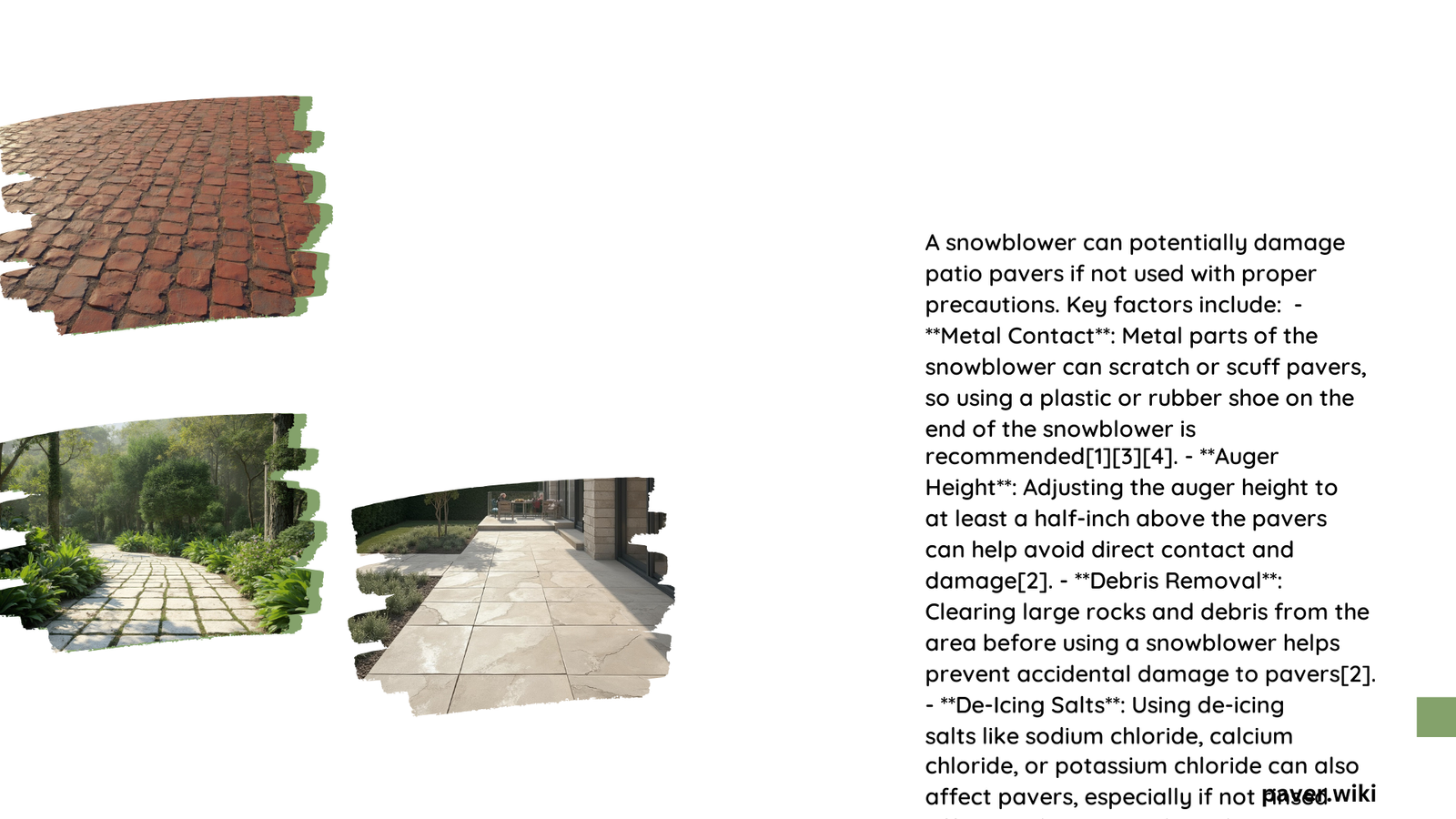Snowblowers can potentially damage patio pavers, depending on the type of snowblower, paver material, and operating technique. Using a snowblower with a rubber guard or auger is generally safer for pavers. Single-stage snowblowers are less likely to cause damage due to their lighter weight. The risk of damage increases with metal parts, improper adjustment, and uneven paver surfaces. Proper snowblower selection and careful operation can minimize the risk of damaging patio pavers.
What Types of Snowblowers Are Safe for Patio Pavers?
When it comes to protecting your patio pavers from snowblower damage, choosing the right equipment is crucial. Here are some snowblower types and features that are generally safer for use on patio pavers:
- Snowblowers with Rubber Guards or Augers:
- These models have a protective layer that prevents direct contact between metal parts and pavers.
-
Example: Toro Power Max e24 60V Two-Stage Snow Blower (with rubber-edged auger)
-
Single-Stage Snowblowers:
- Lighter weight and simpler design make them less likely to cause damage.
-
Examples:
- Worx Nitro 40V Power Share 20-Inch Snow Blower
- Skil Power Core Single-Stage Snow Blower
-
Electric Snowblowers:
- Often lighter than gas-powered models, reducing the risk of paver damage.
- Tend to have fewer metal components that could potentially scratch or gouge pavers.
How Does Snowblower Operation Affect Different Paver Materials?

The impact of snowblowers on patio pavers can vary depending on the paver material:
- Concrete Pavers:
- Generally durable but can be scratched or gouged by metal parts.
-
Less susceptible to damage compared to other materials.
-
Brick Pavers:
- More prone to damage due to softer material composition.
-
Require extra caution when using snowblowers.
-
Natural Stone Pavers:
- Most susceptible to damage due to natural textures and potential for cracking.
- Highest risk of visible damage from snowblower use.
To minimize damage across all paver types:
– Use snowblowers with rubber guards or augers.
– Adjust the snowblower height to avoid direct contact with pavers.
– Consider alternative snow removal methods for sensitive areas.
What Conditions Increase the Risk of Paver Damage from Snowblowers?
Several factors can contribute to an increased risk of paver damage when using a snowblower:
- Snow Depth:
- Deep snow increases pressure on the snowblower’s auger and scraper.
-
This added pressure can lead to more forceful contact with pavers.
-
Paver Installation Quality:
- Unevenly installed or loose pavers are more susceptible to damage.
-
A stable, even surface reduces the risk of snowblower parts catching on pavers.
-
Paver Surface Texture:
- Textured face pavers (e.g., interlock pavers) pose a higher risk.
-
Metal parts can more easily catch between textured pavers.
-
Snowblower Adjustment:
- Improperly adjusted height can cause the auger or scraper to contact pavers directly.
-
Correct adjustment is crucial for preventing damage.
-
Operator Technique:
- Applying excessive pressure or moving too quickly can increase damage risk.
- Careful, controlled operation is essential for paver protection.
What Are the Estimated Costs for Repairing Snowblower-Damaged Pavers?
The cost of repairing paver damage caused by snowblowers can vary widely based on several factors:
| Paver Type | Cost per Paver | Labor Cost (per hour) |
|---|---|---|
| Concrete | $5 – $15 | $50 – $100 |
| Brick | $3 – $10 | $50 – $100 |
| Natural Stone | $10 – $50 | $50 – $100 |
Factors affecting total repair costs:
– Extent of damage (single paver vs. entire section)
– Paver material and quality
– Accessibility of the damaged area
– Local labor rates
For minor damage, costs might be limited to replacing a few pavers. However, extensive damage could require redoing entire sections of the patio, significantly increasing both material and labor costs.
How Can Paver Damage from Snowblowers Be Prevented?
To protect your patio pavers from snowblower damage, consider the following preventive measures:
- Choose the Right Snowblower:
- Opt for models with rubber guards or augers.
-
Consider lighter, single-stage snowblowers for paved surfaces.
-
Proper Adjustment and Operation:
- Set the snowblower height to avoid direct contact with pavers.
-
Move slowly and avoid applying excessive pressure.
-
Protect Vulnerable Areas:
- Use alternative methods (e.g., shoveling, de-icing) for sensitive paver sections.
-
Consider temporary protective coverings for high-risk areas.
-
Regular Maintenance:
- Keep pavers in good condition with proper sealing and maintenance.
-
Address any loose or uneven pavers promptly to reduce damage risk.
-
Snow Removal Timing:
- Clear snow before it becomes too deep or compacted.
- This reduces the force needed to remove snow, lowering damage risk.
By implementing these preventive strategies, you can significantly reduce the risk of snowblower damage to your patio pavers while still efficiently managing snow removal.
